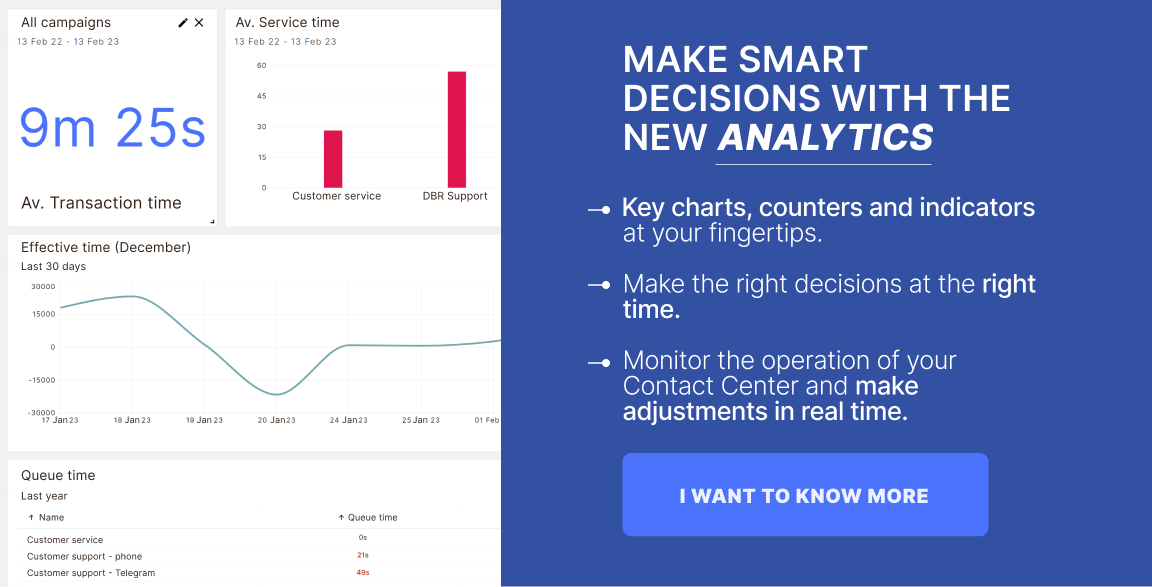In today’s business world, where competition is fierce and customer expectations are ever higher, informed and agile decision making is crucial to the success of any business. In this context, real-time monitoring in the contact center has become an essential tool to improve decision-making and optimize operational efficiency.
Here we will explore what real-time monitoring in the contact center consists of and the tangible benefits it can bring to your business. Do you know how it differs from historical analysis? We will explain it here, too!
Understanding real-time monitoring: a game changer
Real-time monitoring in the contact center refers to the constant and instant monitoring, that is, at the exact moment they occur, of the interactions between agents and customers, whether through calls, chats, email or social networks. This practice involves real-time monitoring and analysis of key performance metrics such as call duration, average holding time, first contact resolution rate, and customer satisfaction.

Real benefits for your business
- Informed Decision Making: Real-time monitoring allows contact center leaders to get instant insight into team performance and customer satisfaction level. This makes it easier to make informed decisions, adjust strategies, and allocate resources more efficiently.
- Resource optimization: By looking at metrics in real time, you can identify patterns and trends in workload. This allows you to make an intelligent redistribution of resources, assigning additional agents at times of high demand and reducing capacity at quieter times.
- Improved Agent Performance: Real-time monitoring gives supervisors the opportunity to provide instant feedback to agents. So agents can adjust their focus and skills in real time, which translates into more effective and satisfying customer service.
- Reduced resolution time: Supervisors or leaders can step in and provide additional assistance to agents when they are faced with complex issues. This reduces the time customers spend waiting for a resolution and improves the overall customer experience.
- Increased customer satisfaction: Real-time monitoring allows you to detect customer dissatisfaction instantly. By promptly addressing these issues, you can increase their satisfaction by demonstrating your commitment to their well-being and proactively resolving their concerns.
- Identification of improvement opportunities: By analyzing the data in real time, you can identify areas for improvement in your processes, systems and agent training. This allows you to implement quick and effective changes.

Historical analysis: the path to continuous improvement
This type of analysis involves the careful study of data collected over time to identify patterns, trends, and areas for improvement. It offers a deeper and contextualized perspective. Some key advantages are:
- Long-term trend identification: Historical analysis allows you to detect patterns and changes in performance over certain time periods (which you can choose), which can be essential for short, medium, and long-term strategic planning.
- Process optimization: By studying historical data, you can identify bottlenecks and areas of inefficiency in processes, allowing you to make systemic improvements.
- Training and development: You can identify areas where agents need additional training and design custom development programs.
Combined approach: the best of both worlds
While the choice between real-time monitoring and historical analysis may seem like a binary decision, the reality is that the two approaches complement each other. The advantages of this combined approach are:
- Proactive Alerts: Use real-time monitoring to set automatic alerts for situations you already know are critical. These alerts can be based on specific thresholds for key metrics, allowing you to intervene immediately.
- Trend Tracking: Combine real-time monitoring with historical analysis to get a complete picture of performance. This allows you to spot long-term trends and take preemptive action based on historical patterns.
- Strategic Planning: Uses historical analysis to guide long-term strategic planning. Evaluate past performance to identify opportunities for improvement and set realistic goals. This way you will also know what metrics you need to analyze in real time.
Conclusion
In the age of data analytics, the power of real-time metrics for contact center success is undeniable. By carefully analyzing metrics such as wait time, abandonment rate, FCR, AHT, customer satisfaction, and agent occupancy, companies in the contact center industry can make more informed and strategic decisions. The ability to quickly adapt to changing customer needs and optimize equipment performance is what separates the leaders in the industry. Take advantage of real-time monitoring and historical analysis to unravel success in your contact center and create an exceptional experience for your customers.
Get to know Analytics, EVOLUTION’s real-time and historical monitoring panel

It is customizable (in terms of style and functionality), it has multiple graphics and visualizations that can be used for Wallboards. They can be configured with a simple drag & drop, changing the size and layout according to your needs at all times.
If you have questions or want to start using EVOLUTION in your contact center, request a demo here.





